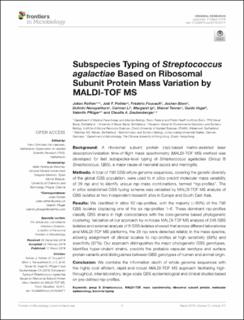Please use this identifier to cite or link to this item:
https://doi.org/10.21256/zhaw-4797Full metadata record
| DC Field | Value | Language |
|---|---|---|
| dc.contributor.author | Rothen, Julian | - |
| dc.contributor.author | Pothier, Joël F. | - |
| dc.contributor.author | Foucault, Frédéric | - |
| dc.contributor.author | Blom, Jochen | - |
| dc.contributor.author | Nanayakkara, Dulmini | - |
| dc.contributor.author | Li, Carmen | - |
| dc.contributor.author | Ip, Margaret | - |
| dc.contributor.author | Tanner, Marcel | - |
| dc.contributor.author | Vogel, Guido | - |
| dc.contributor.author | Pflüger, Valentin | - |
| dc.contributor.author | Daubenberger, Claudia A. | - |
| dc.date.accessioned | 2019-03-14T07:17:48Z | - |
| dc.date.available | 2019-03-14T07:17:48Z | - |
| dc.date.issued | 2019 | - |
| dc.identifier.issn | 1664-302X | de_CH |
| dc.identifier.uri | https://digitalcollection.zhaw.ch/handle/11475/16069 | - |
| dc.description.abstract | Background: A ribosomal subunit protein (rsp)-based matrix-assisted laser desorption/ionization time-of-flight mass spectrometry (MALDI-TOF MS) method was developed for fast subspecies-level typing of Streptococcus agalactiae (Group B Streptococcus, GBS), a major cause of neonatal sepsis and meningitis. Methods: A total of 796 GBS whole genome sequences, covering the genetic diversity of the global GBS population, were used to in silico predict molecular mass variability of 28 rsp and to identify unique rsp mass combinations, termed “rsp-profiles”. The in silico established GBS typing scheme was validated by MALDI-TOF MS analysis of GBS isolates at two independent research sites in Europe and South East Asia. Results: We identified in silico 62 rsp-profiles, with the majority (>80%) of the 796 GBS isolates displaying one of the six rsp-profiles 1-6. These dominant rsp-profiles classify GBS strains in high concordance with the core-genome based phylogenetic clustering. Validation of our approach by in-house MALDI-TOF MS analysis of 248 GBS isolates and external analysis of 8 GBS isolates showed that across different laboratories and MALDI-TOF MS platforms, the 28 rsp were detected reliably in the mass spectra, allowing assignment of clinical isolates to rsp-profiles at high sensitivity (99%) and specificity (97%). Our approach distinguishes the major phylogenetic GBS genotypes, identifies hyper-virulent strains, predicts the probable capsular serotype and surface protein variants and distinguishes between GBS genotypes of human and animal origin. Conclusion: We combine the information depth of whole genome sequences with the highly cost efficient, rapid and robust MALDI-TOF MS approach facilitating high-throughput, inter-laboratory, large-scale GBS epidemiological and clinical studies based on pre-defined rsp-profiles. | de_CH |
| dc.language.iso | en | de_CH |
| dc.publisher | Frontiers Research Foundation | de_CH |
| dc.relation.ispartof | Frontiers in Microbiology | de_CH |
| dc.rights | http://creativecommons.org/licenses/by/4.0/ | de_CH |
| dc.subject | Mass spectrometry | de_CH |
| dc.subject | Diagnostics | de_CH |
| dc.subject.ddc | 540: Chemie | de_CH |
| dc.subject.ddc | 570: Biologie | de_CH |
| dc.title | Subspecies typing of Streptococcus agalactiae based on ribosomal subunit protein mass variation by MALDI-TOF MS | de_CH |
| dc.type | Beitrag in wissenschaftlicher Zeitschrift | de_CH |
| dcterms.type | Text | de_CH |
| zhaw.departement | Life Sciences und Facility Management | de_CH |
| zhaw.organisationalunit | Institut für Umwelt und Natürliche Ressourcen (IUNR) | de_CH |
| dc.identifier.doi | 10.21256/zhaw-4797 | - |
| dc.identifier.doi | 10.3389/fmicb.2019.00471 | de_CH |
| zhaw.funding.eu | No | de_CH |
| zhaw.issue | 471 | de_CH |
| zhaw.originated.zhaw | Yes | de_CH |
| zhaw.publication.status | publishedVersion | de_CH |
| zhaw.volume | 10 | de_CH |
| zhaw.publication.review | Open peer review | de_CH |
| zhaw.webfeed | Umweltgenomik | de_CH |
| zhaw.webfeed | Health Research Hub (LSFM) | de_CH |
| zhaw.funding.zhaw | MALDI-TOF MS for microorganism identification: from pattern recognition towards marker based approaches | de_CH |
| Appears in collections: | Publikationen Life Sciences und Facility Management | |
Files in This Item:
| File | Description | Size | Format | |
|---|---|---|---|---|
| 2019_Rothen_Subspecies_typing_of_Streptococcus_agalactiae.pdf | 3.36 MB | Adobe PDF |  View/Open |
Show simple item record
Rothen, J., Pothier, J. F., Foucault, F., Blom, J., Nanayakkara, D., Li, C., Ip, M., Tanner, M., Vogel, G., Pflüger, V., & Daubenberger, C. A. (2019). Subspecies typing of Streptococcus agalactiae based on ribosomal subunit protein mass variation by MALDI-TOF MS. Frontiers in Microbiology, 10(471). https://doi.org/10.21256/zhaw-4797
Rothen, J. et al. (2019) ‘Subspecies typing of Streptococcus agalactiae based on ribosomal subunit protein mass variation by MALDI-TOF MS’, Frontiers in Microbiology, 10(471). Available at: https://doi.org/10.21256/zhaw-4797.
J. Rothen et al., “Subspecies typing of Streptococcus agalactiae based on ribosomal subunit protein mass variation by MALDI-TOF MS,” Frontiers in Microbiology, vol. 10, no. 471, 2019, doi: 10.21256/zhaw-4797.
ROTHEN, Julian, Joël F. POTHIER, Frédéric FOUCAULT, Jochen BLOM, Dulmini NANAYAKKARA, Carmen LI, Margaret IP, Marcel TANNER, Guido VOGEL, Valentin PFLÜGER und Claudia A. DAUBENBERGER, 2019. Subspecies typing of Streptococcus agalactiae based on ribosomal subunit protein mass variation by MALDI-TOF MS. Frontiers in Microbiology. 2019. Bd. 10, Nr. 471. DOI 10.21256/zhaw-4797
Rothen, Julian, Joël F. Pothier, Frédéric Foucault, Jochen Blom, Dulmini Nanayakkara, Carmen Li, Margaret Ip, et al. 2019. “Subspecies Typing of Streptococcus Agalactiae Based on Ribosomal Subunit Protein Mass Variation by MALDI-TOF MS.” Frontiers in Microbiology 10 (471). https://doi.org/10.21256/zhaw-4797.
Rothen, Julian, et al. “Subspecies Typing of Streptococcus Agalactiae Based on Ribosomal Subunit Protein Mass Variation by MALDI-TOF MS.” Frontiers in Microbiology, vol. 10, no. 471, 2019, https://doi.org/10.21256/zhaw-4797.
Items in DSpace are protected by copyright, with all rights reserved, unless otherwise indicated.